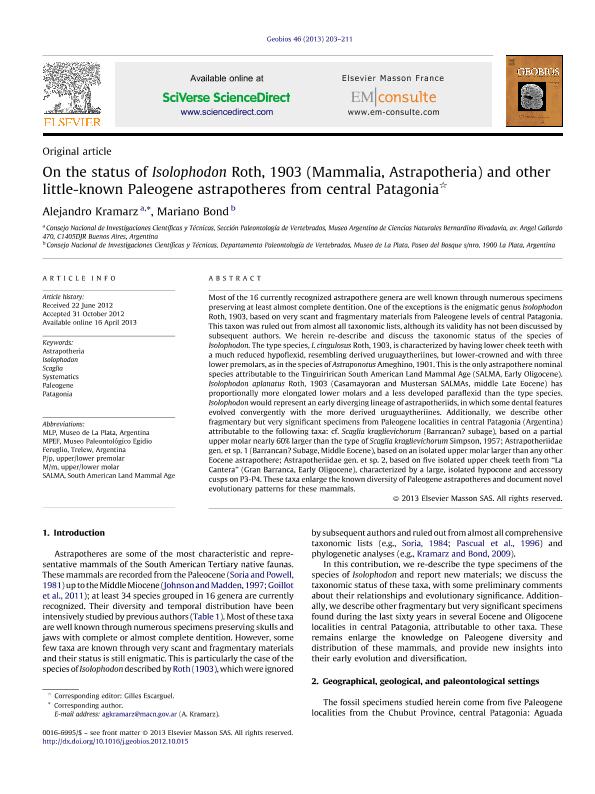Mostrar el registro sencillo del ítem
dc.contributor.author
Kramarz, Alejandro Gustavo

dc.contributor.author
Bond, Mariano

dc.date.available
2017-08-25T20:43:52Z
dc.date.issued
2013-04
dc.identifier.citation
Kramarz, Alejandro Gustavo; Bond, Mariano; On the status of Isolophodon Roth, 1903 (Mammalia, Astrapotheria) and other little-known Paleogene astrapotheres from central Patagonia; Elsevier Masson; Geobios; 46; 3; 4-2013; 203-211
dc.identifier.issn
0016-6995
dc.identifier.uri
http://hdl.handle.net/11336/23048
dc.description.abstract
Most of the 16 currently recognized astrapothere genera are well known through numerous specimens preserving at least almost complete dentition. One of the exceptions is the enigmatic genus Isolophodon Roth, 1903, based on very scant and fragmentary materials from Paleogene levels of central Patagonia. This taxon was ruled out from almost all taxonomic lists, although its validity has not been discussed by subsequent authors. We herein re-describe and discuss the taxonomic status of the species of Isolophodon. The type species, I. cingulosus Roth, 1903, is characterized by having lower cheek teeth with a much reduced hypoflexid, resembling derived uruguaytheriines, but lower-crowned and with three lower premolars, as in the species of Astraponotus Ameghino, 1901. This is the only astrapothere nominal species attributable to the Tinguirirican South American Land Mammal Age (SALMA, Early Oligocene). Isolophodon aplanatus Roth, 1903 (Casamayoran and Mustersan SALMAs, middle Late Eocene) has proportionally more elongated lower molars and a less developed paraflexid than the type species. Isolophodon would represent an early diverging lineage of astrapotheriids, in which some dental features evolved convergently with the more derived uruguaytheriines. Additionally, we describe other fragmentary but very significant specimens from Paleogene localities in central Patagonia (Argentina) attributable to the following taxa: cf. Scaglia kraglievichorum (Barrancan? subage), based on a partial upper molar nearly 60% larger than the type of Scaglia kraglievichorum Simpson, 1957; Astrapotheriidae gen. et sp. 1 (Barrancan? Subage, Middle Eocene), based on an isolated upper molar larger than any other Eocene astrapothere; Astrapotheriidae gen. et sp. 2, based on five isolated upper cheek teeth from ‘‘La Cantera’’ (Gran Barranca, Early Oligocene), characterized by a large, isolated hypocone and accessory cusps on P3-P4. These taxa enlarge the known diversity of Paleogene astrapotheres and document novel evolutionary patterns for these mammals.
dc.format
application/pdf
dc.language.iso
eng
dc.publisher
Elsevier Masson

dc.rights
info:eu-repo/semantics/openAccess
dc.rights.uri
https://creativecommons.org/licenses/by-nc-nd/2.5/ar/
dc.subject
Astrapotheria
dc.subject
Isolophodon
dc.subject
Scaglia
dc.subject
Systematics
dc.subject
Paleogene
dc.subject
Patagonia
dc.subject.classification
Oceanografía, Hidrología, Recursos Hídricos

dc.subject.classification
Ciencias de la Tierra y relacionadas con el Medio Ambiente

dc.subject.classification
CIENCIAS NATURALES Y EXACTAS

dc.title
On the status of Isolophodon Roth, 1903 (Mammalia, Astrapotheria) and other little-known Paleogene astrapotheres from central Patagonia
dc.type
info:eu-repo/semantics/article
dc.type
info:ar-repo/semantics/artículo
dc.type
info:eu-repo/semantics/publishedVersion
dc.date.updated
2017-08-22T14:05:44Z
dc.journal.volume
46
dc.journal.number
3
dc.journal.pagination
203-211
dc.journal.pais
Francia

dc.description.fil
Fil: Kramarz, Alejandro Gustavo. Consejo Nacional de Investigaciones Científicas y Técnicas. Oficina de Coordinación Administrativa Parque Centenario. Museo Argentino de Ciencias Naturales "Bernardino Rivadavia"; Argentina
dc.description.fil
Fil: Bond, Mariano. Universidad Nacional de La Plata. Facultad de Ciencias Naturales y Museo. Departamento Científico de Paleontología de Vertebrados; Argentina. Consejo Nacional de Investigaciones Científicas y Técnicas; Argentina
dc.journal.title
Geobios

dc.relation.alternativeid
info:eu-repo/semantics/altIdentifier/doi/http://dx.doi.org/10.1016/j.geobios.2012.10.015
dc.relation.alternativeid
info:eu-repo/semantics/altIdentifier/url/http://www.sciencedirect.com/science/article/pii/S0016699513000338
Archivos asociados
